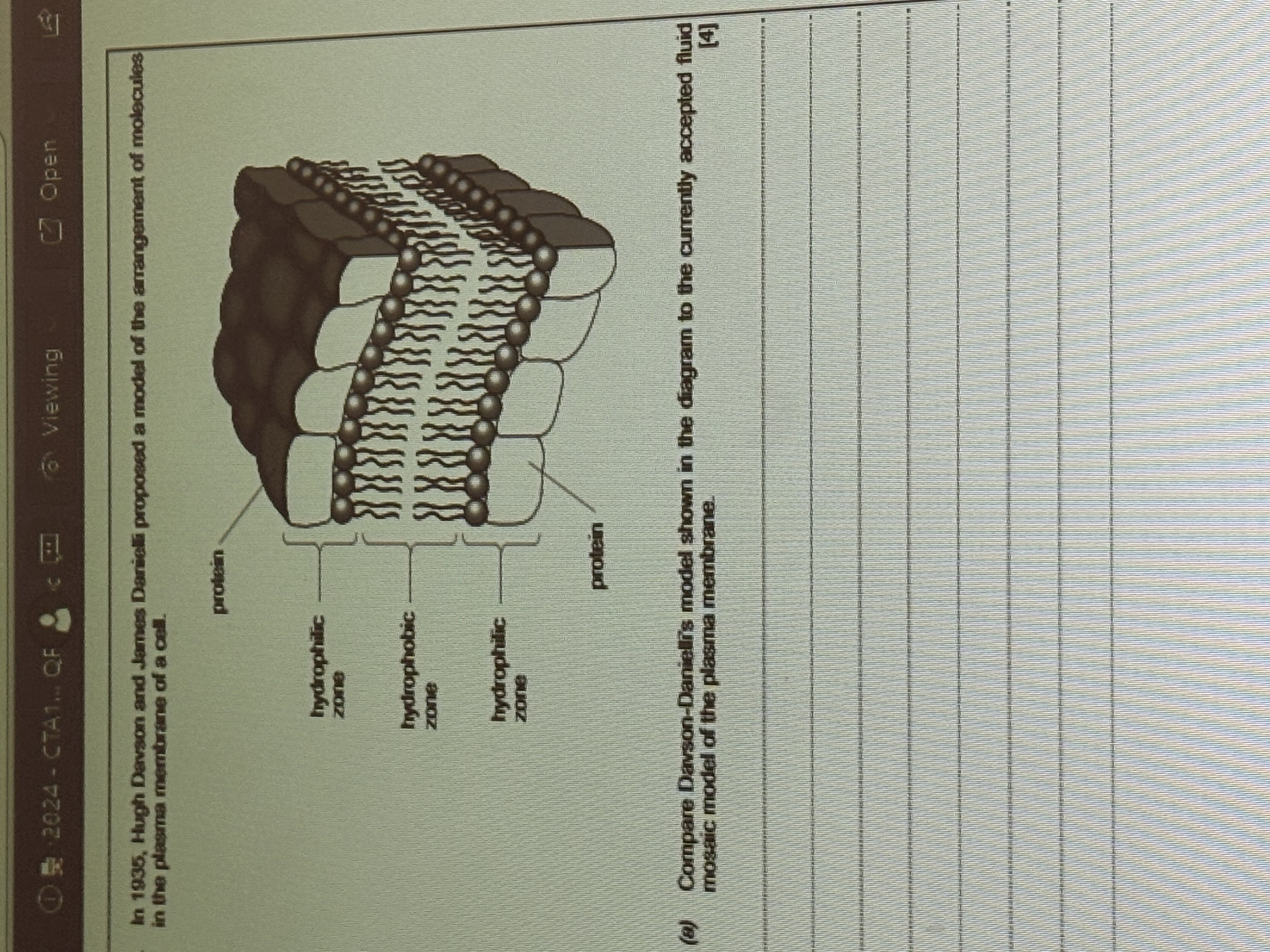cell membranes
1/25
There's no tags or description
Looks like no tags are added yet.
Name | Mastery | Learn | Test | Matching | Spaced |
|---|
No study sessions yet.
26 Terms
Name of model proposed by singer and Nicholson 1972
Fluid mosaic model
Explain how the distinction of charged and uncharged parts determine the position a protein will take up in a membrane
Charged particles will associate with hydrophilic heads
Uncharged particles will associate with hydrophobic tails
For lipid soluble molecules mode of transport, component of the membrane through which it passes, factor affecting rate of transport
MoT: diffusion
Comp: PL bilayer
Factor: concentration gradient
For water soluble molecules in high external concentration
MoT: facilitate diffusion
Compon: channel/ carrier proteins
Factor: concentration gradient/ size of molecule/ pH
Water soluble molecules in low external concentration
MoT: active transport
Compon: carrier proteins
Factor: respiratory rate, ATP production/ pH
Explain the pattern of results of temp against colorimeter reading referring to cell membrane structure
Membrane proteins are stable between .. and .. (at low temps)
Appearance of the red pigment means that the tonoplast and cell membrane has been damaged between .. and … (high temp)
Meaning pigment has leaked out of cell/ sap vacuole/ change in membrane permeability/ damaged membrane
Proteins change shape and denature and come out of bilayer
Explain the difference in results if you were investigating the effect of ethanol on the permeability of the membrane
Dissolve phospholipids/ destroys cell membrane structure
So pigment leaks out
Suggest one problem in performing any investigation using blood
Blood clots/ infection
Explain why the time taken for the RBC to burst (haemolysis) occurred quickest when placed in distilled water
in distilled water Water has highest water WP
Water passed down water potential gradient- from high to low water potential
Passes into the cell by osmosis
A sample of RBC were placed in a concentration solution of sodium chloride draw a diagram to show the expected appearance of one of the blood cell after 5 minutes
Mark scheme says: crinkled cell, high WP inside cell, water passes out of cell causing shrinkage / distortion

Difference between this model and currently accepted fluid mosaic model
Have PL bilayer, hydrophobic takls and hydrophilic heads , have proteins
However for the F-M model proteins are embedded in the lipid layer, there are instrinsci proteins as well as extrinsic
Also the F-M model there are glycocyx, glycolipids, glycoproteins
An investigation was carried out on the uptake of pottasium ions by root tissue stete with reasons the variables that should be kept constant
Temperature or pH BECAUSE
they change enzyme activity, affect reaction rate
Explain why as the O concentration increases the rate of pottasium ions also increases
Active transport is the main method of transport of pottasium ions
Which is energy dependent, uses energy from ATP and oxygen is required for aerobic respiration for ATP production
Greater O concentration produces greater uptake
State the rate of uptake you would expect of a drop of cyanide solution had been added to each of the four solution
They would all be .. (the starting rate of ion uptake)
cyanide inhibits aerobic respiration which prevents or reduces ATP production when no oxygen is present there is still some uptake by diffusion which is a passive process
Explain why increasing the temp increases the permeability of the cell membrane and result in more .. being realised
PL and protein molecules movement increases as temp increases
Creates gaps between PL molecules
Protein loses tertiary structure as hydrogen bonds weaken/ break
Pores in membrane proteins get larger
More .. can escape more quickly
Methods of transport that transports individual molecules or ions
All methods except endocytosis and exocytosis (bulk) : D, FD, OSM, AT
Don’t understand the last question on the FA on membranes, it is too confusing but mention plasma membrane model: fluid mosaic model
Describe the function of the PL bilayer
Physical barrier, selectively permeable membrane allows diffusion or transport of small non polar molecules
Function of intrinsic or channel/ carrier proteins
Allows FD / AT/ transport of large or polar molecules or ions
Explain why no glycocalyx is present in the inner mitochondrial membrane
No need for recognition/ receptor
Explain why there are more carrier/ channel proteins in inner mitochondrial membrane than cell membrane
More FD/ active transport
Maybe transport of ATP
Evidence that P ions can occur both by AT and Diffusion explain how evidence supports this conclusion
Absorption is highest with oxygen which indicates active transport as this requires ATP
Also occurs in the abdomen e of oxygen which indicates diffusion as this is not dependent on respiration passive process
Explain how the properties of the head and the tail of the chlorophyll molecules results in its position in the PT memrbane
Hydrophobic tail and fatty acid hydrophobic regions of the memrbane
Head is hydrophilx
Suggest an adv of the position of the chlorophyll molecules
Holds chlorophyll head in optimum position for absorption of light
Explain how glucose is reabsorbed from the filtrate into the blood even at very high blood glucose levels
Na+ ions actively transported out of epithelial cell lowering the concentration of Na+ inside
Na+ in filtrate at higher concentrated than inside the cell
Na+ Co transported with glucose into epithelial cell
Glucose concentration in epithelila cell is higher than blood plasma
Glucose moves out of epithelial cell into blood by FD
Circulation maintains plasma concentration below that in epithelial cells maintains concentration gradient